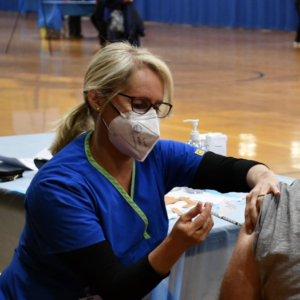Angry over a “lack of transparency” in the data shared at a Sunday afternoon meeting with Pennsylvania’s Acting Health Secretary Alison Beam, leaders in the Delaware Valley issued a joint statement criticizing the state health department for lagging vaccine distribution and no solid explanation as to why.
“We have no way to assess how the data presented to us today was calculated, and how those calculations have been used to determine the number of doses that have been allocated to our four counties,” the statement reads. “Additionally, we were not given any indication of the plan to make up acknowledged shortfalls to certain counties going forward.”
The public move by the leaders of Bucks, Chester, Montgomery and Delaware counties to place blame on the state follows a Feb. 27 article in the Philadelphia Inquirer reporting the counties received far lower vaccine allocations than counties with far fewer residents. In the prepared statement, suburban county leaders said the Sunday Zoom meeting was the result of “repeated requests” for a meeting to explain the unequal distribution to their communities.
Citing long waiting lists and canceled second dose appointments, the leaders said, they were prompted by “understandable frustration and anger among our constituents.”
For example, in Bucks County, the health department received 5,010 doses of vaccine last week and of those, 1,500 were Moderna vaccines, said county spokesman Larry King. “Our challenge here, as in other countries, has been getting enough Moderna doses to administer scheduled second doses,” King said.
Even with increased vaccine distribution, there are plenty of people left to vaccinate in this county of more than 600,000. “As of the end of last week, 40,704 people in Bucks County had been partially vaccinated with one dose, while 41,452 people had been fully vaccinated (2 doses),” said King.
In mid-February, Delaware County council member Elaine Paul Schaefer expressed frustration with the state and noted that the county was well-prepared to vaccinate thousands of people a day in the four sites it has set up – but there isn’t enough vaccine to do so. “I can’t express how much work has been put into preparing for the distribution of the vaccines by the county government, and to have the tables turned and information constantly changed along the way is immensely frustrating,” said Schaefer at the February meeting. “People are looking to us for answers or solutions and the truth is, it’s completely out of our hands.”
After that meeting, Delaware County announced that it had not received any vaccine for the week from the state, forcing the county to cancel all second-dose appointments.
Chester, Montgomery and Bucks county leaders have made similar complaints since the vaccine rollout began. In January, Montgomery County Commission Chair Dr. Val Arkoosh remarked that with the 5,000 doses the county was then receiving weekly, the county could expect to finish up vaccinating the 250,000 residents in the 1A category “in a year.”
Substantial progress has been made since January, though, for Montgomery County. Currently, 84,955 residents are partially vaccinated and 42,232 are fully vaccinated in the county, said spokesperson Kelly Cofrancisco.
That still leaves more than 185,000 people on Montgomery County’s 1A waitlist, and the county is currently working on those who registered on January 13.
“All four counties consistently have received from the Pennsylvania Department of Health far smaller amounts of vaccine than requested, while less-populated counties elsewhere in the state have received disproportionately large amounts of Pfizer and Moderna vaccine,” the statement reads.
Since the newest tool in the fight against COVID-19 – the Johnson & Johnson vaccine -is being distributed by the state to education employees to prepare schools for in-person learning, distribution is being handled by the state, not the counties.
Given that much of the population in the 1A category – or those deemed most vulnerable to COVID-19, have not yet been vaccinated, the question of when counties will be able to vaccinate people in the 1B category – which includes workers who deal with the public daily like police officers, remains unanswered.
The county leaders’ statement lays out exactly what they want to learn from the PA Department of Health:
“Together we call on Acting Secretary Beam to swiftly do the following:
- Create a publicly available chart showing the amount of vaccine from all sources, including Federal partnerships, that has been delivered to each county each month; a description of the County Index that the PA Department of Health is currently using to allocate to each county; and how the index has been applied to each county since the index came into use in late January.
- Explain how and when counties that are lagging in vaccine delivery will receive additional vaccines.
- Explain how vaccine providers will be monitored going forward to ensure that no vaccine provider moves on to vaccinate 1B individuals (beyond the teachers and educational support personnel) until all countries in the Commonwealth have received sufficient vaccines to vaccinate their 1A population.”

